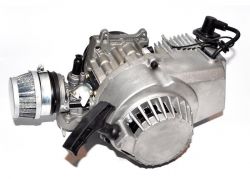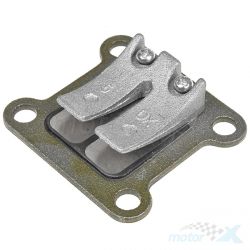FAQ
TL;DR: One bottom screw verifies fuel flow; "After unscrewing it, the fuel should run down." If fuel reaches the carb but it still won't start, briefly choke the intake to prime, then service the carb. This FAQ helps mini cross/quad owners diagnose no-start and stalling. [Elektroda, andrzej55, post #17220927]
Why it matters: It saves time by ruling out fuel-supply faults before deeper 2‑stroke checks.
Quick Facts
- Fuel tap orientation: with the hose inlet vertical/up, the petcock is open. [Elektroda, kowalsky34, post #17220410]
- Float-bowl check: remove the bottom drain screw; fuel should flow freely if supply is OK. [Elektroda, andrzej55, post #17220927]
- 2T intake: a diaphragm (reed) valve sits between carb and engine; if stuck, mixture won’t pass. [Elektroda, andrzej55, post #17223166]
- Diagnostics: after cranking, a dry plug suggests no fuel; confirm spark and compression next. [Elektroda, jack63, post #17222031]
How do I quickly check if fuel is reaching the carburetor?
Open the tank tap, then crack the float-bowl drain screw. Fuel should flow out. If it doesn’t, the tank tap, line, or filter is restricted. Restore flow before adjusting the carb. This single test confirms supply to the carb inlet and bowl. [Elektroda, andrzej55, post #17220927]
Which way is the fuel tap open on these mini cross tanks?
Set the petcock so the hose connection points vertically upward. That position is open. If set otherwise, flow is restricted or closed and the engine will starve. Verify flow at the bowl drain after setting the tap. [Elektroda, kowalsky34, post #17220410]
It only fires when I pour fuel into the cylinder. What should I do?
Strip the carb fully and clean every jet and passage. Blow out the nozzles with compressed air and reassemble with fresh gaskets if needed. Recheck fuel flow at the bowl drain before refitting. This restores metering when the idle and main circuits are clogged. [Elektroda, Pedros050, post #17218687]
It ran for about 5 minutes, then died and won’t restart. Where to look?
Check ignition and sealing first. Inspect spark strength to ground, verify compression, and look under the magneto cover for fuel or wetness from a leaking crankshaft seal. A leaking seal upsets mixture and causes stalling and hard restarts. [Elektroda, jack63, post #17222031]
My plug stays dry after cranking—what’s the first check?
Verify spark quality first. "A spark first. It's a moment ..." Use a proper tester or observe a strong blue arc. Then move to fuel checks. A dry plug means mixture isn’t entering the cylinder, so diagnose supply and metering next. [Elektroda, jack63, post #17222962]
Fuel drips from the exhaust. What’s likely wrong?
Inspect the diaphragm (reed) valve between the carb and cylinder. If reeds stick open or are damaged, mixture can pool and escape via the exhaust. Replace warped or chipped petals and reseal the cage to restore proper one-way flow. [Elektroda, andrzej55, post #17223166]
How can I help the engine prime after service or sitting?
During cranking, briefly obstruct the air intake to increase vacuum and draw fuel through the circuits. "You can still help suck fuel into the cylinder by obstructing the air intake." Do this only for a second or two to avoid flooding. [Elektroda, andrzej55, post #17220927]
How do I quickly diagnose a 2T mini cross that won’t start?
- Check spark strength and plug condition.
- Confirm compression feels normal while kicking or pulling.
- Remove the magnet cover; if you see fuel, a crank seal likely leaks and needs replacement.
These three checks separate ignition, mechanical, and sealing faults fast. [Elektroda, jack63, post #17222031]
Which notch should the carb needle clip use as a baseline?
Use the middle clip as a starting point. Test ride and adjust one step at a time. Lower the clip (raises needle) to richen midrange, raise the clip to lean it. Recheck plug color and response after each change. “Mikuni Tuning Manual”
What baseline mixture screw setting should I start with?
Start at approximately 1.5 turns out from lightly seated on the air/mixture screw. Warm the engine, then adjust for highest idle and clean throttle response. Revisit idle speed to keep a steady tick-over after mixture changes. “Keihin PWK Tuning Guide”
How long should the spark jump be during a bench test?
A healthy small-engine ignition will jump about 6 mm (1/4 inch) in air using an adjustable tester. A shorter, weak, or yellow spark suggests coil, plug, or ground issues. Verify connections and try a known-good plug first. “Briggs & Stratton Ignition Troubleshooting”
Could a clogged silencer cause dying and brief restarts?
Yes. If the quad dies after riding and restarts only briefly, check the silencer for internal collapse or blockage. Also review fuel delivery, because starving can mimic exhaust restriction. Replace blocked packing or the silencer if needed. [Elektroda, uqaniek, post #17559760]
Carb, diaphragm, and coil are new but it still stalls—what next?
Don’t assume new parts fix root causes. Inspect the exhaust for blockage, verify tank venting, and recheck fuel flow at the bowl. Then test spark strength and seals under the magneto. These steps matched cases where replacement didn’t resolve stalling. [Elektroda, uqaniek, post #17559760]
Why is there a dry plug even though the carb gets fuel?
Fuel reaching the carb doesn’t guarantee cylinder delivery. A stuck diaphragm (reed) can block the mixture path. Inspect and replace the reed assembly if it doesn’t seal. Then retest starting and plug wetting after cranking. [Elektroda, andrzej55, post #17223166]




